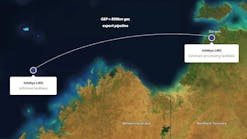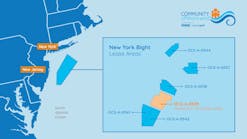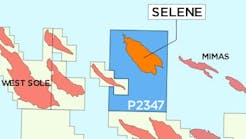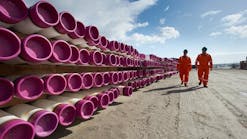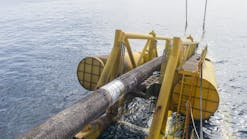Offshore staff
HOUSTON – Intecsea/Worley Parsons Group have a new semisubmersible deepwater platform concept for wet or dry tree applications.
According to a paper delivered at DOT, the Damper Chamber Platform Semi (DCC Semi) is similar to a conventional semisubmersible, with a ring pontoon and four columns supporting a topsides load. But with the DCC Semi, the columns are configured with free-flooding inner chambers.
During quayside integration and the subsequent wet-tow to the location, the configurations of the columns and their large-diameter bottom sections provide substantial displacement and water plane area for stability. Unlike conventional semis, the volume of the pontoons and the column spacing is not determined by the pre-service conditions, and can be optimized to improve the platform’s response for in-service operations.
This arrangement, the authors said, avoids unnecessary displacement in the column simply to control the column-pontoon ratio, a normal requirement under pre-service conditions. Consequently, displacement with the DCC Semi can be reduced compared with conventional semi designs. Also, the column spacing based on in-service conditions helps reduces the deck steel requirements.
The inner chambers are flooded naturally at a draft deeper than both the quayside and wet-tow drafts. Once flooded, water inside the inner chambers provides “free” added mass that suppresses the semi’s motions, especially heave, by increasing the heave natural period at the in-place draft. It also helps optimize the column-pontoon volumetric ratio, an important factor in reducing the platform heave response.
The columns are constructed using a group of small-diameter cylinders. A skirt fitted at the lower end of the columns increases viscous damping through the vortex shedding at the skirt’s edge.
In the presentation, the authors compare a DCC Semi with a conventional semi for a deepwater (1,830 m, or 6,003 ft) wet-tree application in the Gulf of Mexico. The DCC Semi in this case has been designed to support a total payload of 17,000 metric tons (18,739 tons), comprising 10,200 metric tons (11,243 tons) for the topsides, and 6,800 metric tons (7,495 tons) for the 24 steel catenary risers (SCRs) and eight umbilical lines.
According to the comparisons, both designs provide a heave natural period of around 20 seconds, which is typical for GoM semisubmersibles. However, the DCC Semi’s displacement is around 30% less than that needed by the conventional semi to support the same payload. Also, the estimated steel requirement for the DCC Semi’s hull is 33% lower. The skirt appears to provide increased heave damping, reducing resonant responses, which is important in extreme sea states.
As for the dry tree version, the persentatione showed the results of a DCC Semi in 2,438 m (8,000 ft) water depth supporting a total payload of 29,030 mt (32,000 t). This is broken down into 12,700 mt (14,000 t) for the topsides, 4,536 mt (5,000 t) for the drilling rig, 15 top-tensioned risers with a payload of 7,258 mt (8,000 t), and 16 SCRs with a payload of 4,536 mt (5,000 t). The design assumes a nominal tensioner stiffness of 219 kn/m (15 kips/ft).
The favorable features of the DCC Semi in this application, the authors concluded, are a fairly small wave frequency motion response, especially in the heave direction in a harsh environment, and a high payload/hull steel efficiency. The design stroke appears to be within the existing stroke limit of the RAM-type tensioner, rendering the DCC Semi suitable for dry tree applications.
02/02/2010
